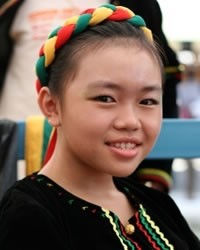Dusun, Kwijau in Malaysia

Photo Source:
MySabah.com
Used with permission
|
Send Joshua Project a map of this people group.
|
| People Name: | Dusun, Kwijau |
| Country: | Malaysia |
| 10/40 Window: | Yes |
| Population: | 13,000 |
| World Population: | 24,000 |
| Primary Language: | Kuijau |
| Primary Religion: | Ethnic Religions |
| Christian Adherents: | 30.00 % |
| Evangelicals: | 6.00 % |
| Scripture: | Translation Started |
| Ministry Resources: | No |
| Jesus Film: | No |
| Audio Recordings: | No |
| People Cluster: | Borneo-Kalimantan |
| Affinity Bloc: | Malay Peoples |
| Progress Level: |
|
Introduction / History
The Kadazan-Dusun people are the largest indigenous grouping in Sabah. One of their subgroups is the Bunda Dusan, defined by their language of the same name.
Although the census counts them as a single people group, there are in fact more than twenty Dusun ethnolinguistic people groups. The largest of these are the Central Dusun, Coastal Kadazan, Labuk-Kinabatangan Kadazan, Bundu Dusun, Rungus Dusun, Tambunan Dusun, Kimaragang, and Tempasuk Dusun.
Although these various people groups are scattered across more than half of the state, in the western, northern, and central portions, most of them reside in the interior, typically along one of the many rivers, rather than in coastal areas. An exception is the Coastal Kadazan who live along the west coast in the Penampang and Papar Districts.
The Kwijau Dusans speak Kuijau.
What Are Their Lives Like?
Kwijau Kwijau Dusuns are all primarily agriculturalists with rice growing supplemented by vegetable gardening and animal husbandry. Many have also found jobs in the timber industry, which has boomed in recent decades. Village life is usually communal, but those in urban areas tend to be less so. Although many hold on to certain aspects of their culture, their lifestyle in urban and developed areas is very different from that in the remote rural areas.
What Are Their Beliefs?
Kwijau Dusuns were traditionally animists but have been influenced by both Christianity and Islam. Many of those that the government counts as Christians come from a church tradition where any child that is born into a family that calls itself Christian is also considered to be Christian.
Those holding to traditional religion today believe in a spirit world that is especially important in the cycle of rice cultivation as well as major events in the cycle of life. Although believing in a supreme being who created everything, they also attribute spirits to many things in nature such as birds, animals, and plants. The "rice spirit," in particular, plays a prominent role in their beliefs and practices.
What Are Their Needs?
While Kwijau Dusuns have experienced the benefits of an improving educational system and the modern economy, those who live in rural areas in particular have not experienced the same level of progress. For those in the mainstream of modernization, a different problem exists as they try to maintain their cultural heritage and identity.
For those who trust in traditional religions, whether animistic or nominally Christian, the greatest need is for them to hear and respond to the good news.
Prayer Points
Pray that many Kwijau Dusuns would put all their faith in Christ and bear good fruit.
Pray for Kwijau Dusuns who know the Lord to disciple many others.
Pray for the Holy Spirit to call and prepare Kwijau Dusuns to spread Christ's glory in Malaysia.